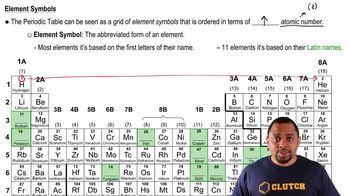Determine the chemical formula of each compound and then use it to calculate the mass percent composition of each constituent element. c. nitrogen triiodide
Ch.3 - Molecules and Compounds
Chapter 3, Problem 125
A metal (M) forms a compound with the formula MCl3. If the compound contains 65.57% Cl by mass, what is the identity of the metal?
 Verified step by step guidance
Verified step by step guidance1
Calculate the molar mass of Cl in the compound MCl_3. Since there are 3 Cl atoms, multiply the atomic mass of Cl (approximately 35.45 g/mol) by 3.
Let the molar mass of the metal M be x g/mol. The molar mass of the compound MCl_3 is then x + 3(35.45) g/mol.
Set up the equation for the mass percentage of Cl: (3(35.45) / (x + 3(35.45))) * 100% = 65.57%.
Solve the equation for x to find the molar mass of the metal M.
Compare the calculated molar mass of M to known molar masses of elements to identify the metal.

Verified video answer for a similar problem:
This video solution was recommended by our tutors as helpful for the problem above.
Video duration:
5mWas this helpful?
Key Concepts
Here are the essential concepts you must grasp in order to answer the question correctly.
Molar Mass and Percent Composition
Molar mass is the mass of one mole of a substance, typically expressed in grams per mole. Percent composition refers to the percentage by mass of each element in a compound. To find the identity of the metal in MCl3, we can use the given percent composition of chlorine to determine the molar mass of the entire compound and subsequently the molar mass of the metal.
Recommended video:
Guided course

Mass Percent Calculation
Stoichiometry
Stoichiometry is the calculation of reactants and products in chemical reactions based on the conservation of mass. In this context, it allows us to relate the mass of chlorine in MCl3 to the mass of the metal. By using the formula and the known mass percentages, we can set up equations to solve for the molar mass of the metal.
Recommended video:
Guided course

Stoichiometry Concept
Periodic Table and Element Identification
The periodic table organizes elements based on their atomic number and properties. Once we calculate the molar mass of the metal from the stoichiometric calculations, we can compare it to known atomic masses of elements in the periodic table to identify the metal. This step is crucial for determining which metal corresponds to the calculated molar mass.
Recommended video:
Guided course

Periodic Table History
Related Practice
Textbook Question
Textbook Question
A Freon leak in the air-conditioning system of an old car releases 38.0 g of CF2Cl2 per month. What mass of chlorine does this car emit into the atmosphere each year?
Textbook Question
Determine the chemical formula of each compound and then use it to calculate the mass percent composition of each constituent element. d. cobalt(II) bromide
Textbook Question
A metal (M) forms an oxide with the formula M2O. If the oxide contains 16.99% O by mass, what is the identity of the metal?
2
views
Textbook Question
Fructose is a common sugar found in fruit. Elemental analysis of fructose gives the following mass percent composition: C 40.00%, H 6.72%, O 53.28%. The molar mass of fructose is 180.16 g/mol. Find the molecular formula of fructose.
